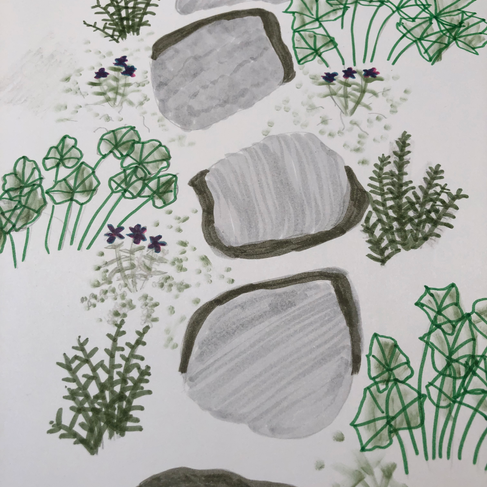Winter Native Gardens: Assessing!
- Nuts for Natives
- Jan 1
- 3 min read
The key to achieving a year round garden.

Winter interest is a phrase written about a lot in the gardening world. I think about it because the more I add to my garden, the more I find myself outdoors in the colder months. I know that is a benefit to me and maintaining a connection to nature year round, experts say, is key to being happier in colder months with shorter days.
Just like taking a black and white photo of your garden during the growing season helps you see whether you have texture and height contrasts, studying your garden in winter helps you see the structure in your garden. Your eye will not be diverted by brightly colored flowers or butterflies and the like. You are staring at the "bones" of your garden: typically hardscape, focal points and evergreens.
Photos & Notes
If you like what you see, great job! You probably are likely to be outdoors more during the winter. If you are like me, you may have made progress but see more opportunities. Taking photos and noting ideas now is the way to remember what you want to change or add once the weather warms up and there are so many other things calling for attention. What you were thinking about in winter, can easily be overlooked in spring. With photos and notes, it will be right there for you.
Sketching
Another great way to assess your winter native garden is to spend 20 minutes or so a day outside sketching your garden for several days in a row. I learned about this approach during a garden design course I took at Chanticleer Garden a while back. When our instructor asked us all to arrive outdoors for sketching every morning, you could hear the collective "what?" and then murmurs of "I don't know how to sketch." I certainly did not know how to sketch. Once you get yourself out there with a pad and pencils, you will feel compelled to put something on the paper and, as it turns out, everyone can sketch! Once we were all in the groove of it, our instructor explained it is a classic way to get people to really look at their gardens and take in details you simply will not notice otherwise.
Reading
The absolute best information about winter interest I have come across is a book titled "The Winter Garden: Celebrating the Forgotten Season." Reading it makes you want to forget about the other three seasons entirely. That's how good it is! The writing is sublime. British author, Naomi Slade, captures and explains the essence of a great winter garden so clearly. The hard cover book features gorgeous photos of frost covered english gardens. The concepts translate to our gardens completely, I highly recommend it.
As you move through your neighborhood, take note of the gardens that grab your attention at this time of year. The gardens we most notice are likely the ones with winter interest. While none of this is particular to a native garden as opposed to an ornamental garden. I do think creating strong winter interest with natives can be a bit more fun and challenging than with ornamentals. In an ornamental winter garden, you literally can choose plants from around the world that bloom in winter to add to your garden. Think winter blooming Chinese witch hazels (Hamamelis mollis), camelias (Camelia japonica) from south Asia and hellebores (Helleborus) native to Europe and China. Creating winter interest with native plants, a more limited plant palette, takes a bit of extra creativity. If there is one thing native plant gardeners have, it's creativity. And, of course, if you want to add that camelia or hellebore, there is nothing wrong with that either.
If you have more ways of assessing and creating winter interest, please do share below. However you decide to proceed, I hope you get a bit of time outdoors this month in your garden!
Happy Winter Gardening.



































So many good points! It IS so helpful to observe and study the "bones" of the garden. :)
Loved reading this!
The logs/limbs/tree branches that line my gardens are hotspots for insect eaters. I love watching the woodpeckers and friends pull off the bark to find lunch in the rotting wood. It's a 24 hour buffet diner. 😊
Leucothoe is making a beautiful display against dwarf Yaupon Holly this winter in 8b, SE Virginia, Chesapeake Bay watershed. Used as foundation plantings.
Central to the enjoyment and value of the native garden is the life it attracts and supports. In winter the liveliest action comes from birds, of course. Lingering berries and seeds on your native shrubs and forbs, and insects in your trees and the snags and stumps you have left in the landscape will feed the winter birds. Be sure to include a heated birdbath or two and keep them clean and filled. The birds will come!